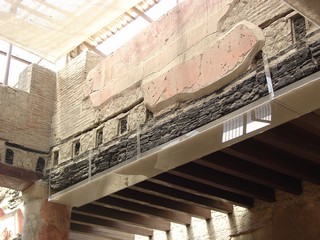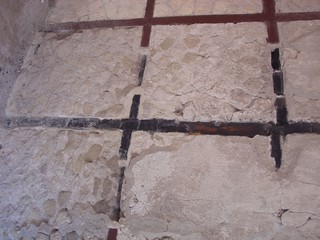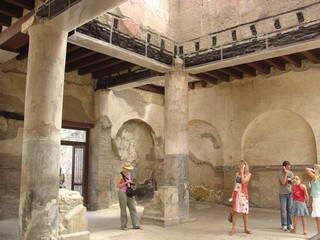Vesuvius, 79 AD
Steven Dutch, Professor Emeritus, Natural and Applied Sciences, University of Wisconsin - Green Bay
 |
In the NASA image at left, Vesuvius is in the center with Naples
above it. At top left is the Campi Flegrei, which is underlain by an
active magma chamber. In this view, north is toward upper right.
The light areas in this picture are urbanized, suggesting the population at risk from Vesuvius. The large blue area is the Bay of Naples, which is separated from the Gulf of Salerno at lower left by the Sorrento Peninsula. |
 |
The NASA radar image at left shows the relief more clearly.
Vesuvius consists of an outer caldera rim called Monte Somma and the inner cone of Vesuvius proper. |
 |
Detail of Vesuvius itself (NASA). Note the outer ring, called Monte
Somma, and the inner cone of Vesuvius proper with its prominent crater.
Herculaneum is below and left of the volcano, Pompeii below and to the right. |
Until the 1980's it had generally been assumed that Monte Somma was prehistoric and that the 79 eruption, though tragic for the unfortunates buried in Pompeii, and for Pliny the Elder, who died while investigating the disaster, was otherwise fairly routine. That all changed in the 1980's when excavations in Herculaneum found hundreds of skeletons of people killed by the eruption, and improved understanding of pyroclastic flows led to better recognition of them.
It now appears that the eruption was a lot more disastrous than once believed and that both Pompeii and Herculaneum were buried by pyroclastic flows. The drop in pressure in the magma chamber allowed the summit to cave in to create Monte Somma, and the present cone of Vesuvius is the result of eruptions since 79. The few Roman depictions of Vesuvius on wall murals all show the volcano as a single cone with no hint of Monte Somma. In addition, medieval and Renaissance depictions of eruptions invariably show the summit of Vesuviusbelow the summit of Monte Somma instead of substantially above it as it is today.
 |
This well known painting in the Archeological Museum in Naples (author's photo) is believed to be of Vesuvius. It appears to show only a single, simple cone with no hint of any surrounding caldera rim. |

Probable situation before 79 AD. Pompeii and Herculaneum are both on the shoreline. Monte Somma is intact and perhaps 2500 meters (8000 feet) high

A cutaway shows the inside of a stratovolcano, a layer cake of lava flows, mudflows and ash layers.

The early stages of the eruption, as attested both by Pliny's account and the ash deposits, involved a vertical eruption column rising to high altitude. The winds carried the ash southeast, and it fell mostly on Pompeii and Stabiae. By the time it fell, it had cooled enough not to be dangerous.
 |
 |
The younger Pliny's celebrated account compared the eruption to a pine tree, and the U.S. Army photo of the 1944 eruption at left and the picture of an Italian pine tree at right show what he meant perfectly.

After several hours, the gas pressure propelling the eruption plume began to falter and the eruption cloud began to collapse and pour down the slope as pyroclastic flows.

Herculaneum, closer to the cone, was hit first. Pompeii continued to receive ash falls.

The pyroclastic flow hit Herculaneum, catching many refugees in flight. Flows may have advanced toward Pompeii but did not reach it yet.
| Charred timbers abound in Herculaneum, testimony to the heat of the pyroclastic flows. |
 |
 |
 |

By the time the pyroclastic flows hit Pompeii, most residents, except for those already buried in ash, had fled. Many could lie buried in the countryside if they were overtaken in flight by the flows.
 |
 |
 |
It's about as subtle as being hit with a brick. The photos above
show a thick layer of small pumice pellets (lapilli) overlain by a much
more fine grained and compact layer with a brick embedded in it. At
right the man is pointing to it.
So the pyroclastic flow, when it hit, was powerful enough to fling bricks. At left is a closeup of the pyroclastic flow layer showing pumice fragments and cross bedding. |
 |
Another view of the lapilli layer with the overlying pyroclastic
layers.
For perhaps a day, the lapilli fall on Pompeii. The lapilli themselves are a nuisance but otherwise not dangerous, but they pile deep enough to impede walking and cause roofs to collapse, and the dust creates a respiratory hazard. Most people escape, but some, perhaps looters, escaped slaves, and people hoping to salvage their valuables, miscalculate and don't make it. How many were on the road and overtaken by the pyroclastic flows, we don't yet know. |

During the collapse, hidden in the ash clouds, the faltering pressure in the magma chamber allows the summit to collapse. The collapse allows still more magma to escape. As it does, escaping gas turns the magma into pumice and the pyroclastic flows become even more powerful.

The collapsing summit with the pyroclastic flows removed.

After the collapse the volcano becomes a shallow ring. The floor is covered with rubble and pyroclastic deposits. Parts of the ring form the present Monte Somma.

Later eruptions build a cone within the caldera. Volcanic deposits and sedimentation leave Pompeii inland.

Medieval and Renaissance depictions of eruptions almost invariably show the summit of Vesuvius below the summit of Monte Somma.

Present day. The high north and east rim of Monte Somma remains as an encircling ridge but the western and southern parts are largely buried by the recent cone of Vesuvius.
Return to Virtual Field Trips Index
Return to Professor Dutch's Home Page
Created 15 January 2007, Last Update 10 June 2020